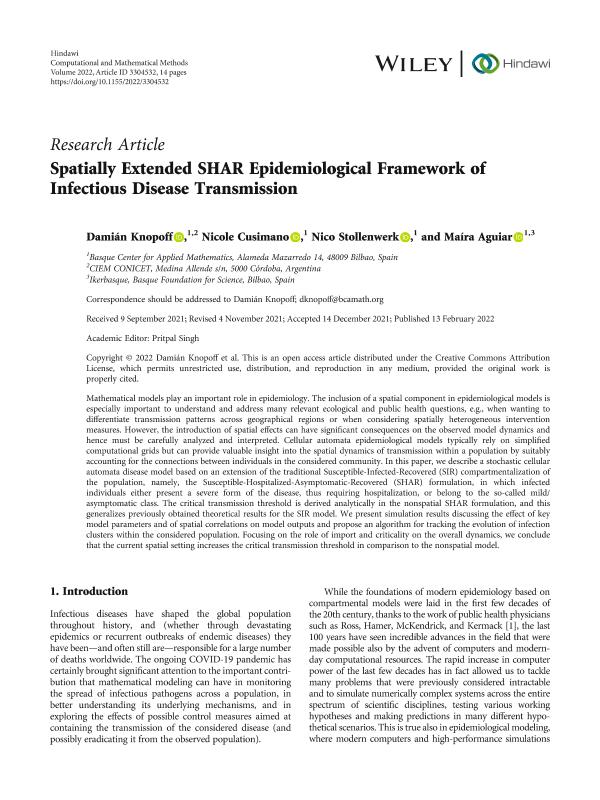Mostrar el registro sencillo del ítem
dc.contributor.author
Knopoff, Damián Alejandro

dc.contributor.author
Cusimano, Nicole
dc.contributor.author
Stollenwerk, Nico
dc.contributor.author
Aguiar, Maíra
dc.date.available
2023-07-12T11:34:12Z
dc.date.issued
2022-02-13
dc.identifier.citation
Knopoff, Damián Alejandro; Cusimano, Nicole; Stollenwerk, Nico; Aguiar, Maíra; Spatially extended SHAR epidemiological framework of infectious disease transmission; Hindawi Publishing Corporation; Computational and Mathematical Methods; 3304532; 13-2-2022; 1-14
dc.identifier.issn
2577-7408
dc.identifier.uri
http://hdl.handle.net/11336/203395
dc.description.abstract
Mathematical models play an important role in epidemiology. The inclusion of a spatial component in epidemiological models is especially important to understand and address many relevant ecological and public health questions, e.g., when wanting to differentiate transmission patterns across geographical regions or when considering spatially heterogeneous intervention measures. However, the introduction of spatial effects can have significant consequences on the observed model dynamics and hence must be carefully analyzed and interpreted. Cellular automata epidemiological models typically rely on simplified computational grids but can provide valuable insight into the spatial dynamics of transmission within a population by suitably accounting for the connections between individuals in the considered community. In this paper, we describe a stochastic cellular automata disease model based on an extension of the traditional Susceptible-Infected-Recovered (SIR) compartmentalization of the population, namely, the Susceptible-Hospitalized-Asymptomatic-Recovered (SHAR) formulation, in which infected individuals either present a severe form of the disease, thus requiring hospitalization, or belong to the so-called mild/asymptomatic class. The critical transmission threshold is derived analytically in the nonspatial SHAR formulation, and this generalizes previously obtained theoretical results for the SIR model. We present simulation results discussing the effect of key model parameters and of spatial correlations on model outputs and propose an algorithm for tracking the evolution of infection clusters within the considered population. Focusing on the role of import and criticality on the overall dynamics, we conclude that the current spatial setting increases the critical transmission threshold in comparison to the nonspatial model.
dc.format
application/pdf
dc.language.iso
eng
dc.publisher
Hindawi Publishing Corporation

dc.rights
info:eu-repo/semantics/openAccess
dc.rights.uri
https://creativecommons.org/licenses/by/2.5/ar/
dc.subject
EPIDEMIOLOGICAL MODELS
dc.subject
SPATIAL MODELS
dc.subject
CELLULAR AUTOMATA
dc.subject
DISEASE TRANSMISSION
dc.subject.classification
Matemática Aplicada

dc.subject.classification
Matemáticas

dc.subject.classification
CIENCIAS NATURALES Y EXACTAS

dc.title
Spatially extended SHAR epidemiological framework of infectious disease transmission
dc.type
info:eu-repo/semantics/article
dc.type
info:ar-repo/semantics/artículo
dc.type
info:eu-repo/semantics/publishedVersion
dc.date.updated
2023-07-05T15:13:41Z
dc.journal.number
3304532
dc.journal.pagination
1-14
dc.journal.pais
Reino Unido

dc.journal.ciudad
Londres
dc.description.fil
Fil: Knopoff, Damián Alejandro. Consejo Nacional de Investigaciones Científicas y Técnicas. Centro Científico Tecnológico Conicet - Córdoba. Centro de Investigación y Estudios de Matemática. Universidad Nacional de Córdoba. Centro de Investigación y Estudios de Matemática; Argentina
dc.description.fil
Fil: Cusimano, Nicole. Basque Center For Applied Mathematics; España
dc.description.fil
Fil: Stollenwerk, Nico. Basque Center For Applied Mathematics; España
dc.description.fil
Fil: Aguiar, Maíra. Basque Center For Applied Mathematics; España
dc.journal.title
Computational and Mathematical Methods
dc.relation.alternativeid
info:eu-repo/semantics/altIdentifier/url/https://www.hindawi.com/journals/cmm/2022/3304532/
dc.relation.alternativeid
info:eu-repo/semantics/altIdentifier/doi/http://dx.doi.org/10.1155/2022/3304532
Archivos asociados
